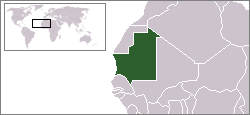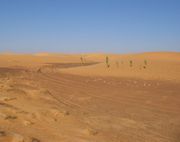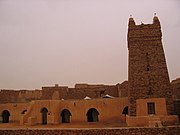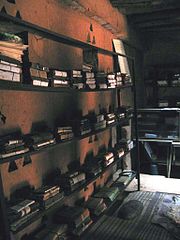Mauritania
From Wikipedia, the free encyclopedia.
- Not to be confused with the ancient kingdom of Mauretania
|
|||||
| National motto: Arabic: شرف إخاء عدل; French: Honneur, Fraternité, Justice (English: Honor, Fraternity, Justice) |
|||||
 |
|||||
| Official language | Arabic, French (de facto) | ||||
| Capital and largest city | Nouakchott 18°09′ N 15°58′ W |
||||
| President of Military Council | Col. Ely Ould Mohamed Vall (named interim leader by the Military Council for Justice and Democracy) | ||||
| Prime Minister | Sidi Mohamed Ould Boubacar | ||||
| Area - Total - % water |
Ranked 28th 1,030,700 km² Negligible |
||||
| Population - Total (2005) - Density |
Ranked 129nd 3,086,859 2.6/km² |
||||
| GDP (PPP) - Total (Year) - GDP/head |
Ranked 148th $4.891 billion $1,700 |
||||
| Currency | Ouguiya | ||||
| Time zone | UTC | ||||
| Independence | 28 November 1960, from France | ||||
| National anthem | National Anthem of Mauritania | ||||
| Internet TLD | .mr | ||||
| Calling Code | 222 | ||||
The Islamic Republic of Mauritania, or Mauritania, is a country in northwest Africa. Its coast faces the Atlantic Ocean on the west, with Senegal on the south-west, Mali on the east and south-east, Algeria on the north-east, with the Moroccan-annexed territory of Western Sahara on the north-west. The capital and largest city is Nouakchott, located on the Atlantic coast. It is named after the ancient Berber kingdom of Mauretania.
Contents |
History
- Main article: History of Mauritania
From the 3rd to 7th centuries, the migration of Berber tribes from North Africa displaced the Bafours, the original inhabitants of present-day Mauritania and the ancestors of the Soninke. The Bafours were primarily agriculturalist, among the first Saharan people to abandon their historically nomadic lifestyle. With the gradual desiccation of the Sahara, they headed South. Following them came a migration of not only Central Saharans into West Africa, but Berbers and Arabs as well. By the Eleventh Century AD, the once small Bafour people had grown into a very large and wealthy Soninke empire - Ghana, which stretched from Mauritania into the neighboring states of Senegal and Mali. Likewise, in the North, the Arab-Berber population had achieved an impressive empire of their own, the territory of which stretched across the Mediterranean into Spain and Portugal. Local nomadic Berber tribes, on the other hand, though influential, remained largely without power, having been conquered by the Soninke.
In 1076, Islamic warrior monks (Almoravid or Al Murabitun) attacked and conquered the ancient Ghana Empire. Over the next 500 years, Arabs overcame fierce resistance from the local population (Berber and non-Berber alike) and came to dominate Mauritania. The Mauritanian Thirty-Year War (1644-74) was the unsuccessful final effort to repel the Yemeni Maqil Arab invaders led by the Beni Hassan tribe. The descendants of the Yemeni Beni Hassan warriors became the upper stratum of Moorish society. Berbers retained influence by producing the majority of the region's Marabouts — those who preserve and teach Islamic tradition. Many of the Berber tribes proclaimed the origin of Yemen (as they sometimes did an Arab one); there is yet little evidence to suggest this, though some studies do link a connection between the two. [1] Hassaniya, a mainly oral, Berber-influenced Arabic dialect that derives its name from the Yemeni Beni Hassan tribe, became the dominant language among the largely nomadic population. Aristocrat and servant castes developed, yielding "white" Moors (the aristocracy), kewri (the indigenous peoples who were never enslaved), and "black" Moors or haratin (the formerly enslaved).
French colonization at the beginning of the 20th century brought legal prohibitions against slavery and an end to interclan warfare. During the colonial period, the population remained nomadic, but many sedentary peoples, whose ancestors had been expelled centuries earlier, began to trickle back into Mauritania. As the country gained independence in 1960, the capital city Nouakchott was founded at the site of a small colonial village, the Ksar, and 90% of the population was still nomadic. With independence, larger numbers of the indigenous peoples (Haalpulaar, Soninke, and Wolof) entered Mauritania, moving into the area north of the Senegal River. Educated in French language and customs, many of these recent arrivals became clerks, soldiers, and administrators in the new state.
Moors reacted to this change by increasing pressure to Arabize many aspects of Mauritanian life, such as law and language. A schism developed between those who consider Mauritania to be an Arab country (mainly Moors) and those who seek a dominant role for the non-Moorish peoples. The discord between these two conflicting visions of Mauritanian society was evident during intercommunal violence that broke out in April 1989 (the "1989 Events"), but has since subsided. The tension between these two visions remains a feature of the political dialogue. A significant number from both groups, however, seek a more diverse, pluralistic society.
Politics
Main article: Politics of Mauritania
Mauritania's presidential election, its third since adopting the democratic process in 1992, took place on November 7, 2003. Six candidates, including Mauritania's first female and first Haratine (former slave family) candidates, represented a wide variety of political goals and backgrounds. Incumbent President Maaouya Sid'Ahmed Taya won reelection with 67.02% of the popular vote, according to official figures, with second-place finisher Mohamed Khouna Ould Haidalla.
The PRDS, led by President Maaouya Ould Sid'Ahmed Taya, has dominated Mauritanian politics since the country's first multi-party elections in April 1992 following the approval by referendum of the current constitution in July 1991. President Taya, who won elections in 1992 and 1997, first became chief of state through a December 12, 1984 bloodless coup which made him chairman of the committee of military officers that governed Mauritania from July 1978 to April 1992. The country's first president, Moktar Ould Daddah, served from independence until ousted in a bloodless coup on July 10, 1978. A group of current and former Army officers launched a bloody but unsuccessful coup attempt on June 8, 2003. The ringleaders remain at large, and their exact motives remain unclear.
Politics in Mauritania have always been heavily influenced by personalities, with any leader's ability to exercise political power dependent upon control over resources; perceived ability or integrity; and tribal, ethnic, family, and personal considerations. Conflict between white Moor, black Moor, and non-Moor ethnic groups, centering on language, land tenure, and other issues, continues to be the dominant challenge to national unity.
The government bureaucracy is composed of traditional ministries, special agencies, and parastatal companies. The Ministry of Interior spearheads a system of regional governors and prefects modeled on the French system of local administration. Under this system, Mauritania is divided into 13 regions (wilaya), including the capital district, Nouakchott. Control is tightly concentrated in the executive branch of the central government, but a series of national and municipal elections since 1992 have produced some limited decentralization.
Political parties, illegal during the military period, were legalized again in 1991. By April 1992, as civilian rule returned, 16 major political parties had been recognized; 12 major political parties were active in 2004. Most opposition parties boycotted the first legislative election in 1992, and for nearly a decade the parliament has been dominated by the PRDS. The opposition participated in municipal elections in January-February 1994 and subsequent Senate elections, most recently in April 2004, gaining representation at the local level as well as three seats in the Senate.
Mauritania, along with Morocco, illegally annexed the territory of Western Sahara in 1976, with Mauritania taking the lower one-third. After several military losses to Polisario, Mauritania retreated in 1979, and their claims were taken by Morocco. Due to economic weakness, Mauritania has been a negligible player in the territorial dispute, with its official position being that it wishes for an expedient solution that is mutually agreeable to all parties.
Military coup
On August 3, 2005, it was reported that the Mauritanian military, including members of the presidential guard, had seized control of key points in the capital of Nouakchott, indicating a possible coup against the government of President Maaouya Ould Sid'Ahmed Taya who was out of the country, attending the funeral of Saudi King Fahd. The group of officers, calling itself the Military Council for Justice and Democracy, released the following statement:
- The national armed forces and security forces have unanimously decided to put a definitive end to the oppressive activities of the defunct authority, which our people have suffered from during the past years. (BBC)
The Military Council later issued another statement naming its president, Colonel Ely Ould Mohamed Vall and listing 16 other officers as members.
The Colonel was himself once regarded as a firm ally of the now ousted President, even aiding him in the original coup that brought him to power, and serving as his security chief afterwards. This high-level betrayal of the former president suggests broad discontentment within the branches of local government, which is further supported by the seemingly complete lack of bloodshed.
The coup was condemned by most world authorities, but local political parties express hope that the Military Council will remain true to its word, and end its leadership after two years — hopefully leading to a democratic government.[2].
In response to the coup and in keeping with their own rules, the African Union suspended Mauritania from all organizational activites.
On August 10, The United States and the African Union dropped demands that the coup be reversed. However the African Union did not reverse the suspension, citing a need for elections before re-admittance.[3]
The Military Council has subsequently released 115 political prisoners of the former government[4] and authorized the return of President Maaouya Ould Sid'Ahmed Taya and some 300 of his political supporters.[5]
Regions

Main article: Regions of Mauritania
Mauritania is divided into 12 regions (capitals in parentheses):
- Adrar (Atar)
- Assaba (Kifa)
- Brakna (Aleg)
- Dakhlet Nouadhibou (Nouadhibou)
- Gorgol (Kaédi)
- Guidimaka (Sélibaby)
- Hodh Ech Chargui (Néma)
- Hodh El Gharbi (Ayoun el Atrous)
- Inchiri (Akjoujt)
- Tagant (Tidjikdja)
- Tiris Zemmour (F'dérik)
- Trarza (Rosso)
The national capital, Nouakchott, comprises a capital district.
Geography
Main article: Geography of Mauritania
Mauritania is generally flat, its 1,030,700 square kilometers forming vast, arid plains broken by occasional ridges and clifflike outcroppings. A series of scarps face southwest, longitudinally bisecting these plains in the center of the country. The scarps also separate a series of sandstone plateaus, the highest of which is the Adrar Plateau, reaching an elevation of 500 meters. Spring-fed oases lie at the foot of some of the scarps. Isolated peaks, often rich in minerals, rise above the plateaus; the smaller peaks are called guelbs and the larger ones kedias. The concentric Guelb er Richat is a prominent feature of the north-central region. Kediet Ijill, near the city of Zouîrât, has an elevation of 1,000 meters and is the highest peak.
Economy
Main article: Economy of Mauritania
Demographics
Main article: Demographics of Mauritania
Culture
Main article: Culture of Mauritania
Trivia
- Mauritania and Madagascar are the only two countries in the world not to use decimal-based currency. The basic unit of currency, the ouguiya, is comprised of five khoums.
Miscellaneous topics
- Communications in Mauritania
- Transportation in Mauritania
- Military of Mauritania
- List of cities in Mauritania
- List of Mauritanian companies
References
External links
Government
- République Islamique de Mauritanie official government site
- Assemblée Nationale Mauritanienne official site
News
- AllAfrica.com - Mauritania news headline links
Overviews
- Arab Gateway - Mauritania
- BBC News Country Profile - Mauritania
- CIA World Factbook - Mauritania
- Library of Congress Country Study - Mauritania data as of June 1988
Directories
- Columbia University Libraries - African Studies: Mauritania directory category
- Looksmart - Mauritania directory category
- Open Directory Project - Mauritania directory category
- Stanford University - Africa South of the Sahara: Mauritania directory category
- The Index on Africa - Mauritania directory category
- Yahoo! - Mauritania directory category
History
Tourism
| Countries in Africa | ||
|
Algeria | Angola | Benin | Botswana | Burkina Faso | Burundi | Cameroon | Cape Verde | Central African Republic | Chad | Comoros | Democratic Republic of the Congo | Republic of the Congo | Côte d'Ivoire | Djibouti | Egypt | Equatorial Guinea | Eritrea | Ethiopia | Gabon | The Gambia | Ghana | Guinea | Guinea-Bissau | Kenya | Lesotho | Liberia | Libya | Madagascar | Malawi | Mali | Mauritania | Mauritius | Morocco | Mozambique | Namibia | Niger | Nigeria | Rwanda | São Tomé and Príncipe | Senegal | Seychelles | Sierra Leone | Somalia/Somaliland | South Africa | Sudan | Swaziland | Tanzania | Togo | Tunisia | Uganda | Western Sahara/SADR | Zambia | Zimbabwe |
||
| Dependencies: British Indian Ocean Territory | Canary Islands | Ceuta and Melilla | Madeira Islands | Mayotte | Réunion | Saint Helena and dependencies | ||









